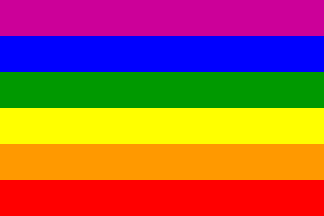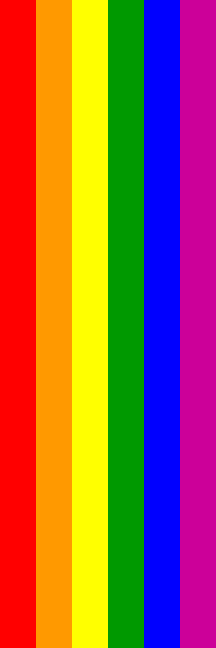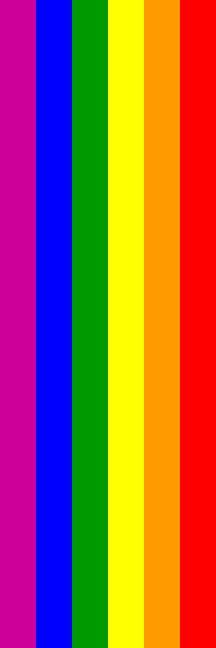
This page is part of © FOTW Flags Of The World website
Gay Pride / Rainbow Flag
Sexual Orientation Flags
Last modified: 2024-01-13 by randy young
Keywords: rainbow flag | baker (gilbert) | stripes: 6 | stripes: 7 | gay pride | vertical variant | vertical stripes |
Links: FOTW homepage |
search |
disclaimer and copyright |
write us |
mirrors
![[Rainbow flag]](../images/s/sex-rb.gif)
image by António Martins, 20 April 1999
See also:
External links:
The rainbow is a symbol of gay pride, as opposed to gay liberation, which used the pink triangle on various colored fields.
Jim Ferrigan, 14 February 2003
The plain 6 stripes does seem to be the flag of choice over the world and probably so for a simple reason of recognition: the flag is often use to mark "gay-friendly" (and in some places, "gay-safe") establishments, so you want to be sure that your target clientele will recognise you.
Marc Pasquin, 26 October 2004
The rainbow flag has become the easily-recognized colors of pride for the gay community. The multicultural symbolism of the rainbow is nothing new and it plays a part in many myths and stories related to gender and sexuality issues in Greek, Native American, African, and other cultures.
M. Schmöger, 26 August 2001
quoting from this page
The rainbow flag [meaning]:
- red: light;
- orange: healing;
- yellow: sun;
- green: calmness;
- blue: art;
- lilac: the spirit;
[black: AIDS awareness]
M. Schmöger, 26 August 2001
translating from EuroGay.NET
The Alyson Almanac: A Treasury of Information for the Gay and Lesbian Community describes Rainbow Flag as follows:
In 1978, Gilbert Baker of San Francisco designed and made a flag with six stripes representing the six colors of the rainbow as a symbol of gay and lesbian community pride. Slowly the flag took hold, offering a colorful and optimistic alternative to the more common pink triangle symbol. Today it is recognized by the International Congress of Flag Makers, and is flown in lesbian and gay pride marches worldwide. In 1989, the rainbow flag received nationwide attention after John Stout successfully sued his landlords in West Hollywood, when they prohibited him from displaying the flag from his apartment balcony. Meanwhile, Baker is still in San Francisco, and still making more flags.
In San Francisco, the Rainbow Flag is everywhere: it can be seen hanging from apartment windows throughout the city (most notably in the Castro district), local bars frequently display the flag, and Rainbow Flag banners are hung from lamp posts on Market Street (San Francisco's main avenue) throughout Pride Month. Visiting the city, one can not help but feel a tremendous sense of pride at seeing this powerful symbol displayed so prominently.
Although the Rainbow Flag was initially used as a symbolof pride only in San Francisco, it has received increased visibility in recent years. Today, it is a frequent sight in a number of other cities as well — New York, West Hollywood, and Amsterdam, among them. Even in the Twin Cities, the flag seems to be gaining in popularity. Indeed, the Rainbow Flag reminds us that ours is a diverse community — composed of people with a variety of individual tastes of which we should all be proud.
Sources used for this article were found at Quatrefoil Library in St. Paul, and include:
- [zom86] "Vexed by Rainbows" by Paul Zomcheck, in Bay Area Reporter (June 26, 1986)
- [u9s89a] "Rainbow Flag" in The Alyson Almanac (1989)
- [u9s90a] "The Rainbow Flag," in Parade 90: San Francisco Gay/Lesbian Freedom Day Parade and Celebration (June 24, 1990)
Christopher Pinette, 12 June 1996
For a long time past the rainbow flag has been a sign under which gays and lesbians declare themselves to homosexuality. The rainbow colours symbolize plurality and love of life. The original version had been designed in 1978 by Gilbert Baker, an artist from San Francisco, and has been changed several times since then due to printing reasons (colours). Over the last years the flag has gained popularity as a symbol. The open display of the flag in different forms (e.g. car sticker, button on clothes) shows, that the gay community has enormously gained in self-confidence. They don't hide themselves any longer, but openly show their gayness in the public.
M. Schmöger, 26 August 2001
translating from BcWsD.COM
It is interesting to note that the flag's colors are used for many other items also - such as mugs, beach towels, T-shirts, etc. - for sale in souvenir shops. Sometimes the actual flag is reproduced and sometimes the colors are used for non-flag design elements, e.g. a T-shirt with six small beach umbrellas embroidered across the front, one in each color of the flag.
Tom Gregg, 20 August 2001
A question about the Rainbow Flag: wasn't it formerly the symbol of the Cooperativist Movement?
Juan Jose Morales, 13 June 2017
Yes, indeed. It was adopted in 1925 until 2001.
Esteban Rivera, 13 June 2017

image by António Martins, 12 January 2000
There is no "right-side up" for this flag. It may be flown either red up or purple up. This information comes directly form Gilbert Baker, the gay artist who conceived of the "The Rainbow Flag" as a symbol of Gay Pride.
James Ferrigan, 26 July 1999
I guess that this applies to the plain rainbow flag and to the horizontally symmetrical variants (pink triangle at hoist, etc.). However, things like the white lambda on a rainbow background or rainbow smiley flag can't be freely hoisted upside down, meaning that they may be produced either with red up or with purple up. However, I'd say that most of those variations are more often with red stripe up, as well as plain rainbow flags, especially those that are produced with such a hoisting device that they cannot be inverted.
António Martins, 27 July 1999
True enough, and yet it somehow underscores that very point, each gay person is free to be "oriented" in any direction, the freedom it give to groups is likewise unique. A survey we conducted in San Francisco showed that the ratio was about 4 to 1 for red to purple up. We used to tell customers fly red up if you're in a good mood! The rainbow with the lambda did come both ways in the 1980s, also we would also give the customer a choice when mounting the flag on poles. The "red up," so far as I know, came from an incorrect handout from Lambda Rising in Washington, D.C.
James Ferrigan, 28 July 1999
I work for COC Nederland, which is the oldest existing gay rights organisation in the world (founded 1946). I have noticed that in Western Europe we use the flag red stripe up, while our colleagues in Eastern Europe use it the other way round. I've seen this use in Romania, Bulgaria and Moldova. The countries in former Yugoslavia use it with the red stripe up, maybe because Yugoslavia was always a "Western European" country.
Maxim van Ooijen, 12 June 2005
The Gay Pride Flags I observed in Provincetown, the US East Coast's gay Mecca, were being flown with the red stripe at the top.
Tom Gregg, 20 August 2001
Not only that there is no "right-side up," but the flags with red and purple stripes up are frequently used together as well. A good example is the photo found here (image). Unfortunately, there is no info on the origin of the photo, except that it was clearly taken before 3 October 2012 and that it is from some Gay Pride event. It is used merely as an illustration of the article, which was published on the date given above, but is rather vaguely related to its content.
Tomislav Todorović, 28 December 2014
![[Vertical rainbow flag]](../images/s/sex-rbv.gif)
image by Joàn-Francès Blanc, 7 July 1999
On a bar at Bergerac/Brageirac (France) displayed at the entrance of the city, a gay flag with vertical stripes.
Joàn-Francès Blanc, 7 July 1999
A more recent sighting of the flag was at the Leeds Pride 2011: https://www.flickr.com/photos/fairynormal/6025945804/. The shades differed somewhatfrom those of 1999: green was visibly lighter than usual, violet was visibly darker, better to be described as purple, and yellow and blue were also slightly lighter as well.
Tomislav Todorović, 20 May 2020
![[Vertical rainbow flag]](../images/q/qq-rbv5.gif)
image by Tomislav Todorović, 14 June 2015
Similar flags with red stripe at the hoist were carried at Atlanta Pride 2009 in Atlanta, Georgia. The photo is available here.
Tomislav Todorović, 14 June 2015
This flag was also used in Portland, Maine, at the South Maine Pride 2006.
Tomislav Todorović, 1 August 2015
Flags with the same design, except somewhat different color shades, were used in Bucharest, Romania at the GayFest 2009 parade. Photos from the event can be found here, here, here, here, here, here, and here. These flags were used again at GayFest 2010, as can be seen here, here, and here.
Tomislav Todorović, 26 December 2015
The flag was also photographed in Toronto, Canada, on 22 June 2016. As it was hoisted next to the national flag of Canada, it was made with the same ratio of 1:2.
Tomislav Todorović, 17 July 2016
The "landscape" variant with red stripe at the hoist was recently used in Kochi, India at the 8th Kerala Queer Pride, which took place on 12 August 2017. The photo album from the event can be found here.
Tomislav Todorović, 2 September 2018
The flag was also used at the 6th Pride March in (Vitoria de) Durango, on 17 June 2017. Photos from the event, available at https://laguna.telediario.mx/noticias/durango/realizan-sexta-marcha-gay-en-durango-marcho-por-mis-derechos (image 1: https://image.laguna.telediario.mx/sites/default/files/styles/article_wider__1x_/public/1efc0635-2bb5-425f-b36f-c97cfc93c310_1.jpg and image 2: https://image.laguna.telediario.mx/sites/default/files/styles/article_wider__1x_/public/04f6d8e0-99b5-42f2-bfa1-3f5c37df0d34.jpg), reveal a variety of color shades appearing in individual flag copies. This was not the first appearance of these flags, for one of them had also appeared in the photo used to illustrate the announcement of the event (http://durango.com.mx/habra-marcha-gay-durango-17-junio/ [image: http://durango.com.mx/wp-content/uploads/2017/06/marcha-gay-en-durango.png]), which consequently must have been made at an earlier event.
Tomislav Todorović, 30 September 2019
![[7-striped vertical rainbow flag]](../images/q/qq-rb7v.gif)
image by Tomislav Todorović, 30 September 2019
Increasing use of vertical variants of 6-striped flag has also inspired the introduction of 7-striped vertical flags. A flag with this design was seen at the 6th Pride March in (Vitoria de) Durango, on 17 June 2017. The photo can be viewed here: https://laguna.telediario.mx/noticias/durango/realizan-sexta-marcha-gay-en-durango-marcho-por-mis-derechos (image: https://image.laguna.telediario.mx/sites/default/files/styles/article_wider__1x_/public/f465430e-add1-48b8-904a-728f83dc7d06.jpg).
Although the flag is not completely visible, the orientation of stripes, with red at the hoist, can still be clearly recognized.
Tomislav Todorović, 30 September 2019

image by M. Schmöger, 22 August 2001
This is a vertical variant of the rainbow flag, actually a Knatterfahne (flapping flag), i.e. a vertical flag with vertical stripes, the red at the hoist. Seen during the CSD (Christopher Street Day) Parade in Munich.
M. Schmöger, 22 August 2001

image by Tomislav Todorović, 6 July 2013
Just like the horizontal variant may be flown either with red or with purple at the top, the "portrait" vertical variant may be flown either with red or with purple at the hoist. The flags with the purple at the hoist were used at the Pride Parade in Jerusalem, on 26 June 2008. Their hoisting was a combination of those of German Knatterflaggen and Auslegerflaggen, only with both the staff and the outrigger going each through a sleeve.
The flags with the same pattern, only hoisted like German Haengeflaggen, were used in Tel Aviv, on 18 July 2005 and in Jerusalem, on 25 June 2009.
Tomislav Todorović, 6 July 2013

image by Tomislav Todorović, 9 June 2015
Another variant, with colors arranged horizontally but in shape similar to the German Auslegerflaggen, only with the outrigger going through the flag sleeve, was seen at Stockholm Pride Parade on 31 July 2010. The photos can be found here and here.
Tomislav Todorović, 9 June 2015
Similar flags, only a bit less oblong, were also used in Hannover, Germany, during the "Demo for All" (Demo für Alle) rally on 22 November 2014. The photos from the event can be found here, here, here, here, here, here and here.
Tomislav Todorović, 19 June 2015
A flag with this design and hoisting like the German Knatterflaggen was seen in Columbus, Ohio, on 17 July 2007.
Tomislav Todorović, 27 June 2015

![[Rainbow flag]](../images/s/sex-rb.gif)

![[Vertical rainbow flag]](../images/s/sex-rbv.gif)
![[Vertical rainbow flag]](../images/q/qq-rbv5.gif)
![[7-striped vertical rainbow flag]](../images/q/qq-rb7v.gif)


